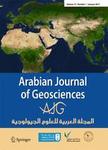版权所有:内蒙古大学图书馆 技术提供:维普资讯• 智图
内蒙古自治区呼和浩特市赛罕区大学西街235号 邮编: 010021

作者机构:Geo-Environment Laboratory Faculty of Earth Science Geography and Territorial Planning University of Science and Technology Houari Boumediene (FSTGAT/USTHB) Alger Algeria Environmental Monitoring Networks Research Laboratory (LRSE) Faculty of Nature and Life Sciences University Oran 1 Oran Algeria Biology of Microorganisms and Biotechnology Laboratory (LBMB) Higher School of Biological Sciences of Oran (ESSBO) Oran Algeria Faculty of Hydraulic Works Technical University of Civil Engineering Bucharest Romania
出 版 物:《Arabian Journal of Geosciences》
年 卷 期:2024年第17卷第6期
页 面:1-16页
学科分类:0709[理学-地质学] 081803[工学-地质工程] 07[理学] 08[工学] 0818[工学-地质资源与地质工程]
摘 要:The Tafna river serves as a model for assessing surface water and environmental quality by combining water quality and pollution indices using multivariate statistical methods. Thirty-six surface water samples were analyzed to assess 13 indicators. The results indicate contamination of the surface waters of the Tafna river by organic matter and the influence of lithology (presence of calcite), leading to an enrichment in Cl−, SO42−, and Ca2+ by dissolution (9.6–4.8 and 4.06 mg.l−1, respectively). During the summer and autumn, pH, electrical conductivity (EC), biochemical oxygen demand (BOD) reaching 57 mg.l−1, chemical oxygen demand (COD) at 90.9 mg.l−1, N-NH4+, and N-NO3− showed significant increases. In addition, the pollution index revealed the absence of pollution during winter and early summer but moderate levels of pollution in autumn. In addition, the spatial distribution of the water quality index (WQI) indicates good water quality in the estuary upstream to 54.94, but progressive deterioration upstream. However, analysis of the correlation matrix highlighted the influence of various sources, both natural and human, on surface water quality. In particular, a significant correlation (R2 = 0.9) was observed between Ca2+ and HCO3− concentrations, indicating a close relationship between these two elements. Organic pollution of the waters of the Tafna river has been strongly influenced by wastewater discharge and agricultural activities, which could lead to potential health risks if consumed. The results of this study provide a sound scientific basis to support decision-making and the implementation of measures to preserve and sustainably manage the Tafna river.